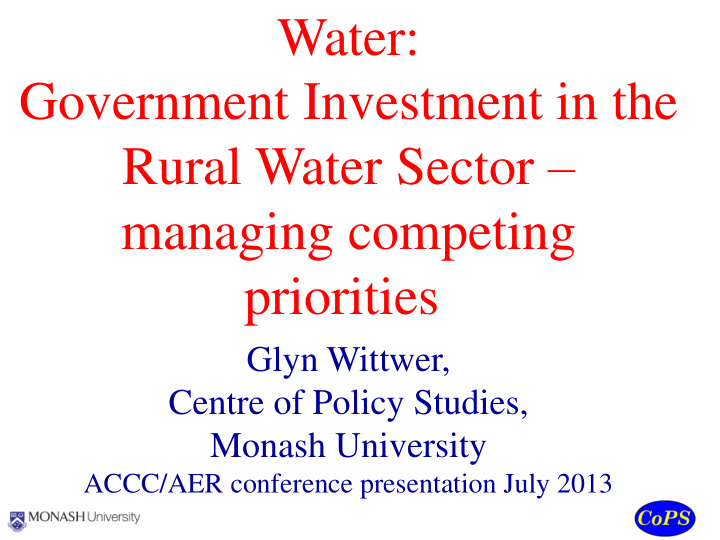



Water: Government Investment in the Rural Water Sector – managing competing priorities Glyn Wittwer, Centre of Policy Studies, Monash University ACCC/AER conference presentation July 2013
Why is public funding of irrigation infrastructure upgrades justifiable?
History and consequences • Foundations of irrigation schemes not based on economics • Soldier settlement schemes • Issues now of sustainability and environmental damage • Public funding necessary to redress environmental concerns and community restructuring
Priorities for such funding • The most obvious examples of market failure • Many farmers using an irrigation facility • Externalities: one irrigator exiting raises costs for those who remain
Some problems as well • We have already observed how state governments behave when Commonwealth money is being used • One example: expressing concerns about the community impacts of less water at the same time as cutting TAFE funding in the basin
Beware overplaying the public funding hand • If an investment can earn an economic return for an enterprise, the incentive for private investment exists • Some justifications for public funding are spurious • Finding ways of spending other people’s money is easy
The perils of multiplier analysis – even in small regions
The context of Leontief’s IO innovation Impacts of mobilising resources for WWII
Leontief’s remarkable feat • Input-output analysis worked well in examining demand shifts (defence mobilisation or de-mobilisation) • Two numbers underline the problem of this methodology in other circumstances: 19% --- 4.7%
Leontief’s remarkable feat • Input-output analysis worked well in examining demand shifts (defence mobilisation or de-mobilisation) • Multipliers aligned with observed changes • Two numbers underline the problem of this methodology in other circumstances: 19% 4.7%
Leontief versus Johansen: the effect on the output of i of a unit increase in exogenous demand for j In Leontief’s world (the 1930s) there is high all 0 Leontief (I-O) unemployment mainly > 0 no upward pressure A) 1 (I on prices of primary all 0 factors from extra demand mainly > 0 In Johansen’s world (the 1950s) there is full Johansen (CGE) mainly < 0 employment upward pressure on T(X,Y) X,Y prices of primary factors from extra mainly < 0 demand
How far can we go with an input- output methodology? • IO is only suitable at the national level in extraordinary circumstances (Great Depression) • But is IO defensible in small regions? • After all, from a regional perspective, supplies are relatively elastic
The problem of perfectly elastic supplies • These are the foundation on which multiplier analysis rests • Any upward price movement in a region renders the usual multiplier analysis invalid
Port Hedland real estate: sale March 2013
Location, location, location
In an input-output multiplier world, what would this house be worth?
The real world sale price $1,425,000
Dynamic computable general equilibrium (CGE) analysis using TERM-H2O 21 23 17 16 2 1 5 4 19 22 3 19 7 6 11 9 18 12 8 10 15 13 14 20
How valuable is additional water? • Context matters • TERM-H2O can depict different future baselines that alter marginal outcomes in scenarios
Water savings • Infrastructure upgrades reduce evaporation and leakage • Improve timeliness of delivery • Other sources might include biotechnological advances, better use of on-farm IT in irrigation equipment • Better infrastructure will improve water tradability – keep the economists happy
A potentially misleading slide: water use in drought % change in 2007-08 relative to 2005-06 Irrigation Apparent Output water used index Dairy -26.5 -64.4 206 Rice -98.2 -97.8 82 21
A potentially misleading slide: water use in drought % change in 2007-08 relative to Water 2005-06 traded Irrigation Apparent for grain Output water used index Dairy -26.5 -64.4 206 Rice -98.2 -97.8 82 Rainfall deficit raised irrigation requirements 22
What we learn from these numbers • For irrigation, our model should include both irrigation water and rainfall • We must include mobility of farm inputs between irrigated and dry-land farming • Water trading enhances this mobility
Our baseline • We include one moderate three-year drought per decade • This affects dry-land productivity without reducing irrigation water availability • You will see in a moment what this means
Our scenarios • (1) Accelerated water savings • (2) Rapid export demand growth for farm products • (1) and (2) together
Water efficiency gains over time (% change from 2008) Water saving, not substitution into dry-land 26
Water price levels best define our baseline & scenarios ($/ML) 27
Water prices ($/ML) 28
Water prices ($/ML) 29
Southern MDB: macro impacts of accelerated water savings, BAU demand growth 1.0 0.9 0.8 0.7 0.6 Drought years 0.5 0.4 Real GDP 0.3 Consumption Drought years 0.2 Employment 0.1 0.0 2008 2010 2012 2014 2016 2018 2020 2022 2024 2026 30
Southern MDB: macro impacts of accelerated demand growth, BAU water savings Px/Pm 1. Since MP L & MP K fixed by assumption in medium term, adjustment to terms-of- trade is via inflows of L and investment, little action on real wages (Q not P adj). 2. Gap between P c and P g keeps growing, so gap between Y and C keeps growing (% deviation from forecast) Ongoing terms of trade improvement 31
Southern MDB: macro impacts of accelerated demand growth, accelerated water savings (% deviation from forecast) 32
Change in composition: rice (% output change relative to 2008) 33
Conclusions • Some public funding of upgrades is necessary • The case for large public irrigation upgrade investments improves as export demand growth accelerates • Be wary of upgrades as an instrument of regional economic renewal: they come a distant second to public funding of essential services
But for the economists … • Since we do know not the future with precision, we need to understand the conditionality of our conclusions on our view of the future
Recommend
More recommend